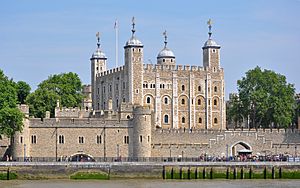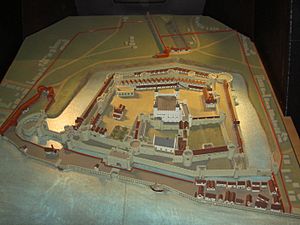Liberties of the Tower of London facts for kids
| Liberties of the Tower of London Tower Liberty |
|
 |
|
| Geography | |
| HQ | Court House, Wellclose Square |
| History | |
| Abolished | 25 June 1894 |
Quick facts for kids Demography |
|
|---|---|
| 1831 population | 4,190 |
| Politics | |
| Governance | Tower Liberty Quarter Sessions |
| Subdivisions | |
| Type | Places |
| Units | # Tower Within
|
The Liberties of the Tower, also known as the Tower Liberty, is a small area in East London. It includes famous places like Tower Hill and the Tower of London. This special area was created after the year 1200. Its main purpose was to keep the land around the Tower clear, making it easier to defend.
For many years, the Liberty was an independent area with its own rules. This lasted until June 25, 1894, when it was officially stopped. Even today, the area keeps some old traditions alive. One well-known example is the custom of beating the bounds.
Contents
History of the Tower Liberty
The Tower Liberty was first set up sometime after the year 1200. Before this, the land was part of the City of London.
What Made Up the Liberty?
The area originally had three smaller parts, called liberties:
- Tower Within: This included the Tower of London itself, its moat (the ditch around it), and a small part of Tower Hill outside the old London Wall.
- Old Tower Without: This was on Tower Hill, outside the Tower but mostly inside the city wall.
- Great Tower Hill: This part was also on Tower Hill, outside the Tower but inside the city wall.
People often used the name Great Tower Hill for the part of Tower Hill inside the city wall. Little Tower Hill was the area outside the wall.
The Liberties had their own separate government. The Constable of the Tower of London was in charge. They had their own coroner (who investigates deaths) and a courthouse. This courthouse held general and quarter sessions (types of court meetings) and even had its own jail. A group of police officers, called constables, worked in the area.
People living in the Liberties had special rights. For example, they could claim any animal that fell from London Bridge. They could also claim any swans found under the bridge. The exact borders of the Liberty were recorded in 1525 and again in 1597.
From the mid-1600s, the Liberty became part of a larger area called the Tower Division or Tower Hamlets. This larger area was also independent from the county of Middlesex. It handled its own local government duties.
How the Liberty Grew
The Liberty grew bigger in 1686. King James II added three small areas to it. These were the Old Artillery Ground, Little Minories, and the Liberty of Wellclose. These areas became part of the Crown's land when the religious groups that owned them were stopped. They were then used to store weapons.
Starting in 1837, the Liberty joined the Whitechapel Poor Law Union. This was a group of areas that worked together to help people in need. From 1855, the Liberty also became part of the Whitechapel District for some local government tasks.
When the Liberty's Role Ended
Over time, the special administrative role of the Liberty slowly faded away. The Tower of London and Old Tower Without became regular civil parishes in 1858. The Old Artillery Ground became a civil parish in 1866.
By 1889, the Liberty was no longer needed for its original purpose. It became part of the new County of London. People thought its legal powers had ended. However, it was found that the Liberty's old charter (a special document granting rights) was still valid. So, the Liberty was officially ended on June 25, 1894. This happened after the local judges asked for it to be abolished.
The Liberty continued to exist for a short time as a special coroner's district. But this role also ended on January 1, 1940. Since 1965, the area has been part of the London Borough of Tower Hamlets in Greater London. Some small parts are now in the City of London after boundary changes in 1994.
Past Population Numbers
In 1811, the population of the Liberty was 3,995 people. By 1831, it had grown to 4,190 people. Most of these people lived in the areas that were added later.
Myths and Legends of the Tower
The Tower of London is very important, and this has given its surrounding area a special place in British stories.
Brân the Blessed and the Ravens
One legend says that the head of Brân the Blessed, a giant and king, was buried on the White Hill. This hill is thought to be either Tower Hill or where the White Tower now stands. The head was placed facing France to protect Britain from invasion. The story says that as long as the head was there, Britain would be safe.
However, a jealous King Arthur supposedly dug up the head. He believed his own strength was enough to protect the country. This mistake, according to the legend, led to the successful Anglo-Saxon invasions.
The name Brân is Welsh for crow or raven. This connects the legend to the famous ravens of the Tower of London. It is said that if the ravens ever leave the Tower, then the Tower, the Crown, and Britain itself will fall.
Beating the Bounds Ceremony
The history of the Liberty is still remembered today through a special ceremony. This event is called beating the bounds. It happens every three years, organized by the Tower authorities and the local church of All Hallows by the Tower. The ceremony takes place on Ascension Day, which is 39 days after Easter Sunday.
During the ceremony, a group walks along the Liberty's 31 boundary stones. At each stone, the Chaplain says, "Cursed is he who removeth his neighbours landmark." Then, the chief warder tells the children, "Whack it boys, whack it!" The children then gently tap the boundary marker with willow sticks. Children take part in these ceremonies because they will remember them for a long time. This helps pass down knowledge about their neighborhood's history.
The boundary includes a small water inlet called Tower Dock. You can even find a pub called 'The Liberty Bounds' nearby. It's named after this historic ceremony.
Open Spaces in the Liberty
Tower Hill Parks
- Trinity Square Gardens: This park includes the Tower Hill Memorial, which honors sailors who died in wars. The gardens are on the spot where many important prisoners were executed in the past.
- Wakefield Gardens
- Tower Gardens
Tower of London Grounds
- Tower Moat: The water-filled ditch around the Tower.
- Tower Green: Another place where several important prisoners were executed.
Tower Beach
The Tower Beach was created in 1934. It was a place for local people to relax by the river, between Tower Dock and Tower Bridge. It was meant to be a permanent beach, but it closed in 1971 because of pollution.
Important Buildings
- Tower of London
- Tower Subway
Famous People from the Liberty
Besides many people connected to the Tower of London, the Liberties were also home to:
- Admiral William Penn: He lived in the area. His son, also named William Penn, was born here. This son later founded the state of Pennsylvania in America. Their home was "on the east side, within a court adjoining to London Wall."
- Tubby Clayton: An Anglican clergyman who founded the charity Toc H.


